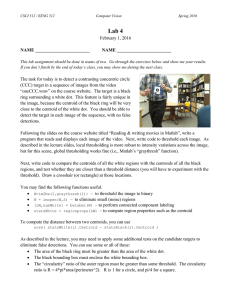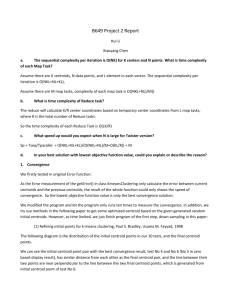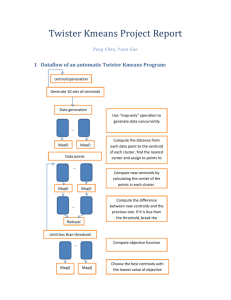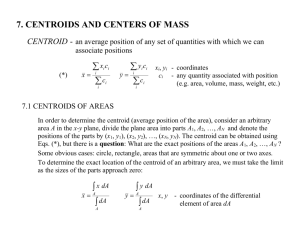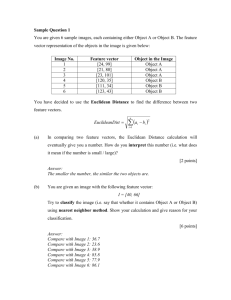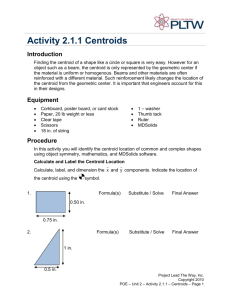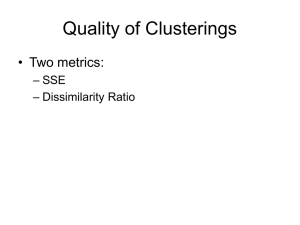Statics_7_lecture_new
advertisement
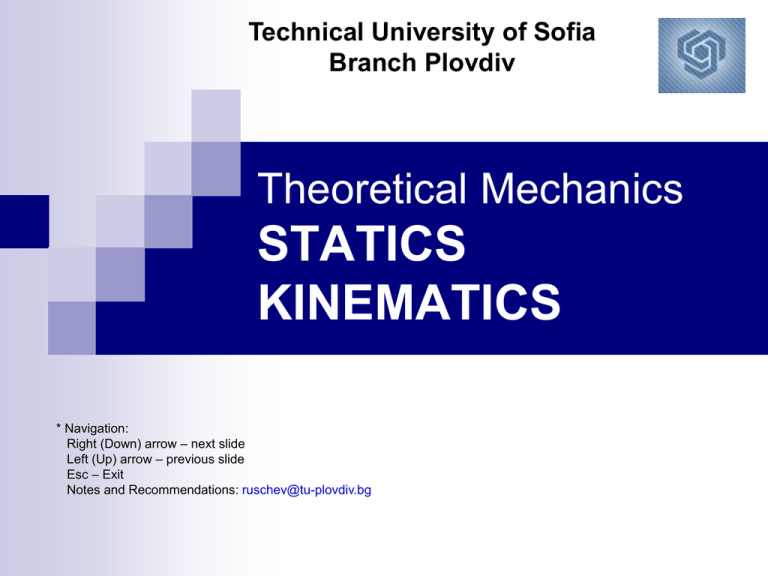
Technical University of Sofia Branch Plovdiv Theoretical Mechanics STATICS KINEMATICS * Navigation: Right (Down) arrow – next slide Left (Up) arrow – previous slide Esc – Exit Notes and Recommendations: ruschev@tu-plovdiv.bg Lecture 7 Distributed Loads Sometimes, a body may be subjected to a loading that is distributed over its surface. For example, the pressure of the wind on the face of a sign, the pressure of water within a tank, or the weight of sand on the floor of a storage container, are all distributed loadings. Lecture 7 Distributed Loads Line Distribution. When a force is distributed along a line, as in the continuous vertical load supported by a suspended cable, the intensity w of the loading is expressed as force per unit length of line, newtons per meter (N/m) or pounds per foot (Ib/ft). Area Distribution. When a force is distributed over an area, as with the hydraulic pressure of water against the inner face of a section of dam, the intensity is expressed as force per unit area. This intensity is called pressure for the action of fluid forces and stress for the internal distribution of forces in solids. The basic unit for pressure or stress in SI is the newton per square meter (N/m2), which is also called the pascal (Pa). Lecture 7 Distributed Loads Volume Distribution. A force which is distributed over the volume of a body is called a body force. The most common body force is the force of gravitational attraction, which acts on all elements of mass in a body. The determination of the forces on the supports of the heavy cantilevered structure would require accounting for the distribution of gravitational force throughout the structure. The intensity of gravitational force is the specific weight rg, where r is the density (mass per unit volume) and g is the acceleration due to gravity. The units for rg are (kg/m3)(m/s2) = N/m3 in SI units. Lecture 7 Centers of mass and centroids Consider a three-dimensional body of any size and shape, having a mass m. If we suspend the body from any point such as A, the body will be in equilibrium under the action of the tension in the cord and the resultant W of the gravitational forces acting on all particles of the body. This resultant is clearly collinear with the cord. Assume that we mark its position by drilling a hypothetical hole of negligible size along its line of action. We repeat the experiment by suspending the body from other points such as B and C, and in each instance we mark the line of action of the resultant force. For all practical purposes these lines of action will be concurrent at a single point G, which is called the center of gravity of the body. Lecture 7 Centroids of common shapes of areas and lines Lecture 7 Centroids of common shapes of areas and lines Lecture 7 Centroids of common shapes of areas and lines Lecture 7 Centroids of common volumes Lecture 7 Centroids of common volumes Lecture 7 Centroids of common volumes Lecture 7 Centroids of common volumes Lecture 7 Centroids of common volumes Lecture 7 Composite plates and bodies In many instances, a flat plate can be divided into rectangles, triangles, or the other common shapes. The coordinates X and Y of its center of gravity G can be determined from the abscissas x1, x2, . . . , xn and y1, y2, . . . , yn of the centers of gravity of the various parts by expressing that the moment of the weight of the whole plate about the x and y axis is equal to the sum of the moments of the weights of the various parts about the same axis. XW x1W1 x2W2 ... xnWn YW y1W1 y2W2 ... ynWn x1W1 x2W2 ... xnWn W y W y2W2 ... ynWn Y 1 1 W X If the plate has a constant thickness t , density r and area A, its weight is W=rgtA. Then the coordinate of G are expressed by the areas A1 , A2 ,…, An of the different components. Lecture 7 Composite plates and bodies Sample problem 1 For the plane area shown, determine the location of the centroid. Solution Components of Area. The area is obtained by adding a rectangle, a triangle, and a semicircle and by then subtracting a circle. Using the coordinate axes shown, the area and the coordinates of the centroid of each of the component areas are determined and entered in the table below. Lecture 7 Sample problem 1 The area of the circle is indicated as negative, since it is to be subtracted from the other areas. We note that the coordinate y of the centroid of the triangle is negative for the axes shown. Lecture 7 Sample problem 1 Component A, mm2 x, mm y, mm xA, mm3 yA, mm3 Rectangle 9.6x103 60 40 576x103 384x103 Triangle 3.6x103 40 -20 144x103 -72x103 Semicircle 5.655x103 60 105.46 339.3x103 596.4x103 Circle -5.027x103 60 80 -301.6x103 -402.2x103 ∑xA=757.7x103 ∑yA=506.2x103 ∑A=13.828x103 Location of Centroid. Substituting the values given in the table into the equations defining the centroid of a composite area, we obtain X 13.828 103 757.7 103 X 54.8 mm Y 13.828 103 506.2 103 Y 36.6 mm Lecture 7 Distributed Loads on Beams Consider a beam supporting a distributed load. This load may consist of the weight of materials supported directly or indirectly by the beam, or it may be caused by wind or hydrostatic pressure. The distributed load can be represented by plotting the load w supported per unit length. This load is expressed in N/m. The magnitude of the force exerted on an element of beam of length dx is dW = w dx, and the total load supported by the beam is L W w dx 0 We observe that the product w dx is equal in magnitude to the element of area dA. The load W is thus equal in magnitude to the total area A under the load curve. The point of application P of the equivalent concentrated load W is obtained by expressing that the moment of W about point O is equal to the sum of the moments of the elemental loads dW about O: L L xW xw dx 0 x xw dx 0 W Lecture 7 Distributed Loads on Beams Three most common cases and the resultants of the distributed loads in each case. Lecture 7 Sample problem 2 Solution • The magnitude of the concentrated load is equal to the total load or the area under the curve. • The line of action of the concentrated load passes through the centroid of the area under the curve. A beam supports a distributed load as shown. Determine the equivalent concentrated load and the reactions at the supports. • Determine the support reactions by summing moments about the beam ends. Lecture 7 Sample problem 2 • The magnitude of the concentrated load is equal to the total load or the area under the curve. F 18.0 kN • The line of action of the concentrated load passes through the centroid of the area under the curve. X 63 kN m 18 kN X 3.5 m Lecture 7 Sample problem 2 • Determine the support reactions by summing moments about the beam ends. M A 0 : B y 6 m 18 kN 3.5 m 0 B y 10.5 kN M B 0 : Ay 6 m 18 kN 6 m 3.5 m 0 Ay 7.5 kN

